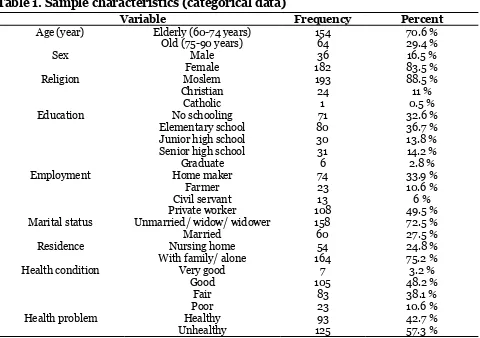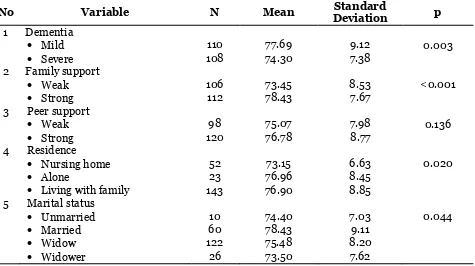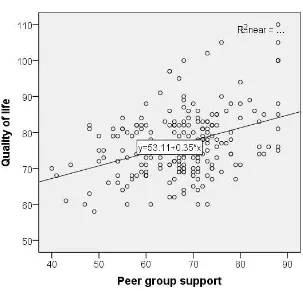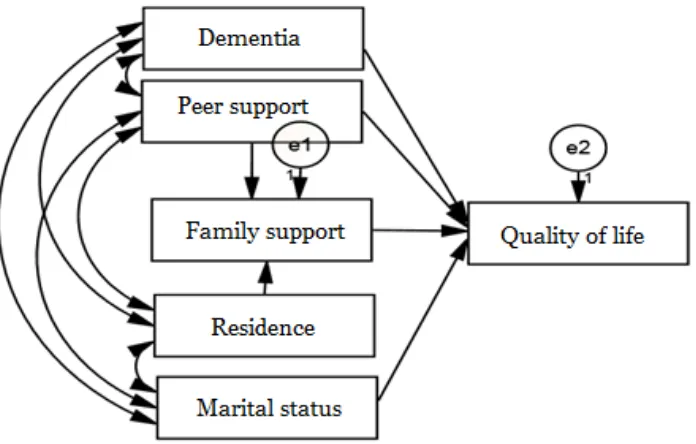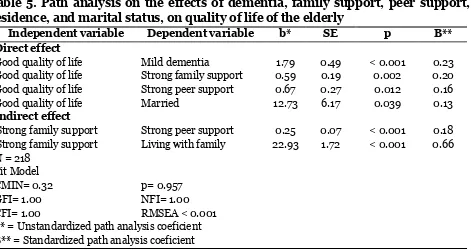Suwarni et al./ Effect of Dementia, Family Support, Peer Support
Effect of Dementia, Family Support, Peer Support, Type
of Residence, and Marital Status on Quality of Life
of the Elderly in Surakarta, Central Java
Sri Suwarni1), RB. Soemanto2), Aris Sudiyanto3)
1)School of Health Polytechnics, Ministry of Health, Surakarta 2)Faculty of Social and Political Sciences, Universitas Sebelas Maret 3)Department of Psychiatry, Faculty of Medicine, Universitas Sebelas Maret
ABSTRACT
Background: The aging population is increasing in Indonesia and worldwide. Indonesia is one of the countries that has high aging population structure. As such, the quality of life of the elderly is of major concern. This study aimed to determine the effect of dementia, family support, peer support, type of residence, and marital status on quality of life of the elderly in Surakarta, Central Java.
Subjects andMethod: This was an analytical observational study with cross-sectional design. A total sample of 218 elderly people in Surakarta, Central Java, was selected for this study by fixed exposure sampling, with 1:3 ratio consisting of 50 elderly people living in Dharma Bakti nursing home and 168 elderly people living with their families in the community. The dependent variable was health-related quality of life. The independent variables were dementia, family support, peer support, type of residence, and marital status. The data were collected by questionnaire and analyzed by path analysis.
Results: Better quality of life of the elderly was directly increased by strong peer support (b= 0.25, p<0.001), strong family support (b= 0.59, p= 0.002), mild dementia (b= 1.79, p<0.001), and being married (b= 12.73, p= 0.039). Better quality of life was also increased indirectly by strong peer support (b= 0.67, p= 0.012) and living with families (b= 22.93, p<0.001), through family support.
Conclusion: Better quality of life of the elderly is directly increased by strong peer support, strong family support, mild dementia, and being married. It is indirectly increase by strong peer support and living with families.
Keyword: quality of life, dementia, family support, peer support, elderly
Correspondence:
Sri Suwarni. School of Health Polytechnics, Ministry of Health, Surakarta. Email: tanasfa@gmail.com
BACKGROUND
Globally, the elderly population is predicted to increase. The proportion of the world population aged 60 years and above is predicted to increase from 12% to 22% in 2015 to 2050 (WHO, 2015). In Indonesia, the population over the age of 60 reaches 21.4 million (BPS, 2015). According to the Ministry of Health RI in 2014, since 2000 the percentage of the elderly population of Indonesia has exceeded 7 percent, which means Indonesia belongs to the group of
countries with advanced age structures. The increase in life expectancy exceeds the birth rate so that the elderly population is high.
quality of life, such as changes in social roles, feelings of loneliness, and dementia.
Referring to the World Health Organization Quality of life (WHOQOL) quality of life is an individual perception of their position in life. Cultural systems and values of residence relate to their goals, expectations, standards, and problems (WHO, 1995). Quality of life is often associated with physical and psychological condition, independence, social interaction, and environment.
Social interaction is very influential in human life in this case elderly. The elderly tendency for lack of socialization, decreased immunity, should do the household chores alone even for family members, is a problem that elderly people face in living the rest of their age. The problems of the physical, psychological, and social aspects that occur in the elderly are interconnected, thus increasing dependence on others. Reduced social contact is associated with declining quality of life in older people (Sok and Choi, 2012). Under these conditions, social support for the elderly is necessary for its well-being (Meléndede-Moral et al., 2013).
High social support lowers the risk of mental disorders, illness, death, and improved quality of life (Karnell et al, 2007; Reblin and Uchino, 2008). Family support, peer support, living environment, is a form of social support needed by the elderly. person needs the fulfillment of spiritual, spiritual, and social needs, for self, family, and society, by upholding human rights and
obligations (Law No. 13 of 1998). Elderly wellbeing can be correlated with the quality of life. Real indicators can be seen from
physical, psychological, and social
relationships.
The research question of this study was whether there are effects of dementia, family support, support of middle-aged friends, residence, and marital status on the quality of life of elderly people.
SUBJECTS AND METHOD 1. Study design
This was an analytic observational study with cross sectional design. The study was
conducted at Dharma Bakti nursing home
and community health center in Pajang, Laweyan, Surakarta, Central Java, from October to December 2017. elderly. The independent variables were dementia, marital status, residence, family support, and peer support.
4.Operational definition of variable The elderly was defined as someone aged from 60 years and above who lived in Parma Bakti Nur Dharma nursing home and participated in the elderly Posyandu in Pajang sub-districts, Surakarta.
Suwarni et al./ Effect of Dementia, Family Support, Peer Support
was defined as a place of advanced age to live and carry on daily activities.
Marital status was defined as the marital status between a man and a woman as husband and wife to form a family.
Quality of life was defined as the subject's assessment of the physical, psychological, relationship or interactional conditions, and social environment.
5.Study instrument
Dementia was measured by modified Mini-Mental State Examination (MMSE). Quality of life was measured by WHOQOL-BREF. Family support and peer support were measured by a set of questionnaire.
Cronbach alpha of dementia, family support, and peer support were 0.96, 0.97, and 0.96, respectively, indicating that the questionnaire was reliable.
6.Data analysis
The univariate analysis used to describe the distribution of study variables and sample
characteristics. The result of the univariate analysis for categorical data was described in frequency and percent. The univariate analysis for continuous data was described in frequency, mean, standard deviation, minimum, and maximum.
The bivariate analysis was used to provide crude estimates of the effect of dementia, marital status, residence, family support, and peer support, on the elderly quality life. The bivariate analysis involving continuous data used Pearson correlation.
The multivariate analysis used path analysis model to determine the direct and indirect associations between endogenous and exogenous variables. Path analysis coefficients were used to measure the magnitude of the effect of variables.
RESULTS 1. Univariate analysis
Table 1. Sample characteristics (categorical data)
Variable Frequency Percent
Age (year) Elderly (60-74 years) 154 70.6 %
Marital status Unmarried/ widow/ widower 158 72.5 %
Table 2. Sample characteristics (continuous data)
Variable N Minimum Maximum Mean Standard Deviation
Dementia 218 0 24 21.31 5.51
Family support 218 19 76 58.40 14.91
Peer support 218 14 60 67.32 10.29
Quality of life 218 45 462 210.98 43.76
2.Bivariate analysis
Bivariate relationship involving continuous data was indicated by Pearson correlation coefficient (Table 3). The quality of life of the elderly was positively correlated with
mild dementia, strong family support, strong peer support, living with family, and living with husband/wife, and these corre-lations were statistically significant.
Table 3. Bivariate relationship involving continuous data between quality of life and other variables, measured by Pearson correlation coefficient
Variable r p
Mild dementia 0.27 <0.001
Strong family support 0.29 <0.001
Strong peer support 0.22 0.001
Living with family 0.21 0.002
Living with husband/wife 0.21 0.002
Table 4. The result of bivariate analysis on the difference of mean quality of life by various independent variables
No Variable N Mean Standard
Deviation p
1 Dementia
Mild 110 77.69 9.12 0.003
Severe 108 74.30 7.38
2 Family support
Weak 106 73.45 8.53 <0.001
Strong 112 78.43 7.67
3 Peer support
Weak 98 75.07 7.98 0.136
Strong 120 76.78 8.77
4 Residence
Nursing home 52 73.15 6.63 0.020
Alone 23 76.96 8.45
Living with family 143 76.90 8.85
5 Marital status
Unmarried 10 74.40 7.03 0.044
Married 60 78.43 9.11
Widow 122 75.48 8.20
Widower 26 73.50 7.62
Table 4 shows that mean quality of life is low if the elderly has severe dementia, weak family support, weak peer group
Suwarni et al./ Effect of Dementia, Family Support, Peer Support
Figure 1. Positive weak correlation between family support
and quality of life
Figure 2. Weak positive correlation between peer group support
Figure 1 shows positive weak corre-lation between family support and quality of life. As expected the stronger family support, the better of quality of life. However, a bivariate analysis is only a suggestion on the direction of the relationship, since it is only a crude analysis that calls for further multivariate analysis to control for confounding factors.
Likewise, Figure 2 shows positive weak correlation between peer support and
quality of life. As expected the stronger family support, the better of quality of life. 3.Path analysis
a. Model specification
b. Model specification illustrates the
relationship between the variables under study. In the current model specification, there is a structural model with six measured variables (Figure 3).
Figure 3. Structural model of path analysis without parameter estimates
b. Model identification
Path analysis can be done if it has a degree of freedom (df) ≥0. The degree of freedom (df) calculation with the following formula: df= observed variable x (observed variable + 1) / 2 – (endogenous variable+ exogenous variable + parameter).
Model identification on the quality of life of elderly determinants including: 1) Number of observed variable: 6 2) Endogenous variable: 2
3) Exogenous variable: 4 4) Parameter: 12
Degreeoffreedom value was 3.
c. Model fit
The goodness of fit between the structural model that has been made with the best variable relation model (saturated model) was checked. The results of checking the model goodness of fit are shown in Figure 2 and Table 4.
Suwarni et al./ Effect of Dementia, Family Support, Peer Support
these indicators confirm that the specified model shows the goodness of fit, as such can be used to estimate the parameters. d. Parameter estimate
Figure 3 shows the path analysis structural model without parameter estimates. Figure 4 shows the path analysis structural model with parameter estimates in the forms of the un-standardized path coefficients. The un-standardized path coefficient (b) shows the strength of the relationship between
dependent and independent variables in the original measurement unit. Therefore, it cannot be used to compare the strength of the relationship between a dependent variable and a number of independent variable. In order to compare the strength of the relationship between a dependent variable and a number of independent variable, the standardized path coefficient can be used instead (see Table 5 the last column).
Figure 4. Structural model of path analysis with parameter estimates
Table 5. Path analysis on the effects of dementia, family support, peer support, residence, and marital status, on quality of life of the elderly
Independent variable Dependent variable b* SE p Β**
Direct effect
Good quality of life Mild dementia 1.79 0.49 < 0.001 0.23 Good quality of life Strong family support 0.59 0.19 0.002 0.20 Good quality of life Strong peer support 0.67 0.27 0.012 0.16
Good quality of life Married 12.73 6.17 0.039 0.13
Indirect effect
Strong family support Strong peer support 0.25 0.07 < 0.001 0.18 Strong family support Living with family 22.93 1.72 < 0.001 0.66 N = 218
Fit Model
CMIN= 0.32 p= 0.957
GFI= 1.00 NFI= 1.00
CFI= 1.00 RMSEA < 0.001
As Table 5 shows, mild dementia (b= 1.79, SE= 0.49, p<0.001), married (b= 12.73, SE= 6.17, p = 0.039), strong family support (b= 0.59, SE= 0.19, p= 0.002), strong peer support (b= 0.67, SE= 0.27, p= 0.012) directly improved quality life of elderly. Quality life of elderly was indirectly affected by living with family member.
DISCUSSION
1. The effect of dementia on the quality of life of the elderly
Decreased cognitive function in the elderly is the cause of inability to perform normal positive atmosphere such as feeling happy and life satisfaction are usually associated with higher quality of life in elderly with dementia. It is recommended to increase support for elderly with dementia to improve quality of life (Nikmat et al, 2015).
The results of path analysis in this study showed the effect of mild dementia variable compared with severe dementia on improving the quality of life of elderly people. Mild dementia effects on high quality of life. In contrast, severe dementia effects on low quality of life in elderly.
This result is in line with Haris et al. (2014) which states that dementia and depression affect the quality of life. Active participation in social activities and interac-tions with others can help to stimulate cognitive function and slow the occurrence of dementia in the elderly. Social activity and social attachment have been shown to have an effect on cognitive function in the elderly (Haris et al, 2014).
2.The effect of family support on the quality of life of the elderly
A family that interacts and is inter-dependent with one another gets
emo-tional, instrumental, informational,
rewarding support. Humans as social beings will be involved in a relationship and dependence. This is a form of support for each other. The support that occurs can be either positive or negative. Positive support will motivate in a good direction, but negative support will have a bad effect.
Positive family support affects the daily activity, physical condition, and mental state. People will be more enthu-siastic about work and move to achieve the personal goal, so that the results will also be maximized. However, negative family support will cause stress, discomfort, laziness, and reluctance to behave, so that the results are not maximal or fail. This sometimes causes stress and despair.
The result of path analysis from the current study indicated that there was a direct effect of strong family support on the improvement of the quality of life. Family serves as a place to share with its members to meet the physical and emotional needs of each individual. Adaptation, partnership, maturity, affection, and togetherness, occur in the family life. Family support is needed during the life of elderly, so that they feel valued and cared for.
Suwarni et al./ Effect of Dementia, Family Support, Peer Support
interacting and communicating, helping to solve problems, and providing support to maximize life satisfaction. Life satisfaction arises from a feeling of calm and comfort. The result of this study is in line with the study by Meidikayanti and Wahyuni (2017) who reported an association between family support and quality of life in patients with type 2 diabetes mellitus.
3.The effect of peer support on the quality of life of the elderly
The result of path analysis in this study indicated that strong peer support directly or indirectly influenced the improvement of the quality of life of the elderly. Direct strong peer support improves the psycho-logical aspect of the quality of life by reducing loneliness and the risk of depression. Strong peer support also affects increased family support.
Peer support motivates the elderly to keep the spirit of continuing life. Friendship provides the beneficial effects of mutual activities and pleasant interactions.
Increased age will cause a decrease in physical ability. This will limit the ability of a person to perform activities of daily living so that the quality of life of the elderly declined. The result of this study is in line with the study by Sreedevi et al. (2017) who reported that peer support increased the social domain of the quality of life of women with diabetes.
4.Effect of residence on the quality of life of elderly people
This study found that residence indirectly affects the quality of life of old age. Residence affects family support and family support affects the quality of life. So dwelling affects the quality of life of elderly subjects through family support.
(Nuryanti, 2012). This condition affects the health status of elderly (Wulandari, 2011).
The results of this study are in line with the results of research Putri et al. (2014) that compares the quality of life of elderly people living in families and homes. 5. Effect of marital status on the quality of life of elderly people
The study found that the marital status of the subject affects the quality of life. Subjects with marital status have a better quality of life than those who do not marry, widow or widower. In the elderly everyday spend more time in the house, so that the existence of a life partner will be very meaningful in the life and mind.
This study concludes that the status of dementia, family support, peer support, shelter, and marital status, affect the quality of life of the elderly.
ACKNOWLEDGEMENT
The author would like to extend gratitude to Municipality Office of Social Affairs for facilitating the access of the nursing home.
REFERENCE
BPS (2015). Statistik penduduk lanjut usia. https://www.bappenas.go.id/files/- data/Sumber_Daya_Manusia_dan_-Kebudayaan/Statistik%20Penduduk% 20Lanjut%20Usia%20Indonesia%20 2014.pdf. Diakses 13 Februari 2017. Clare L, Woods RT, Nelis SM, Martyr A,
Markova IS, Roth I, Whitaker C J, Morris RG (2014). Trajectories of quality of life in early-stage dementia: individual variations and predictors of change. International Journal of Geri-atric Psychiatry, 29(6):616–623. Haris ER, Steven R, Handajani YS (2014).
kalianyar, West Jakarta. Damianus Journal of Medicine.13(2): 117-127. InfoDATIN: Pusat data dan informasi
kementerian kesehatan RI; Situasi lanjut usia (Lanjut usia) di Indonesia 29 Mei 2016 - Hari lanjut usia
Koek MERHL (2016). Predictors of functio-nal disability in mild cognitive im-pairment and dementia. Journal maturitas. MAT 6615.
Krause N (2007). Longitudinal study of so-cial support and meaning in life. Psy-chology and Aging. 22(3): 456–69. Meidikayanti W, Wahyuni CU (2017).
Hu-bungan dukungan keluarga dengan kualitas hidup DM tipe 2 di pus-kesmas Pademawu. JBE; 5(2).
Manurung RPR (2014). Analisis Jalur (Path Analisis); Teori dan Aplikasi Dalam Riset Bisnis; Rineka Cipta Jakarta. Melendez-Moral JC, Charco-Ruiz L,
Mayor-domo-Rodriguwz, Sales-Galan A
(2013). Effects of a reminiscencepro-gram among institutionalized elderly adults. Psicothema. 25(3): 319–23. Nikmat A, Hawthorne G, Al-Mashoor S (2015). The comparison of quality of life among people with mild dementia in nursing home and home care, a preliminary report. De-mentia: The international journal of social research and practice. 14(1): 114-125.
Nuryanti T (2012). Hubungan perubahan peran diri dengan tingkat depresi pada lanjut usia yang tinggal di UPT PSLU Pasuruan, Babat Lamongan.
Available :http://journal.unair.ac.id-/fTitikN.pdf. diakses 22 November 2017.
Putri ST, Fitriana LA, Ningrum A, Sulastri A(2014). Studi komparatif: kualitas hidup lanjut usia yang tinggal ber-emotional support and its implication for health. Curr opin psychiatry. 21(2): 201–5.
Sok S, Choi J (2012). Factors associated quality of life of elderly in non-paid or paid assisted living facilities. Korean J Adult Nurs. 24(2):99–108.
Sreedevi A, Unnikrishnan AG, Karimassery SR, Deepak KS (2017). The effect of yoga and peer support intervention on the quality of life of women with dia-betes: Results of A randomized con-trolled trial. IJEM. 21(4):524-530. Sujarweni (2012). SPSS Untuk Paramedis.
Gava Medika Yogyakarta.
Undang-undang kesejahteraan lanjut usia No.13 tahun 1998.
WHO(1995). The WHOQOL Group. The world health organization quality of life assessment (WHOQOL): Position paper from the world health orga-nization. Social science and medicine. 41: 1403–1409.
WHO (2015). Thematic briefs for the first who ministerial conference on global action against dementia, 16-17.
Gene-va: http://www.who.int/mental
_he- alth/neurology/dementia/thematic_-briefs_dementia/en/. Diakses 6 April 2017.
Suwarni et al./ Effect of Dementia, Family Support, Peer Support
Universitas Diponegoro Semarang. Available:http://eprints.undip.ac.id/
